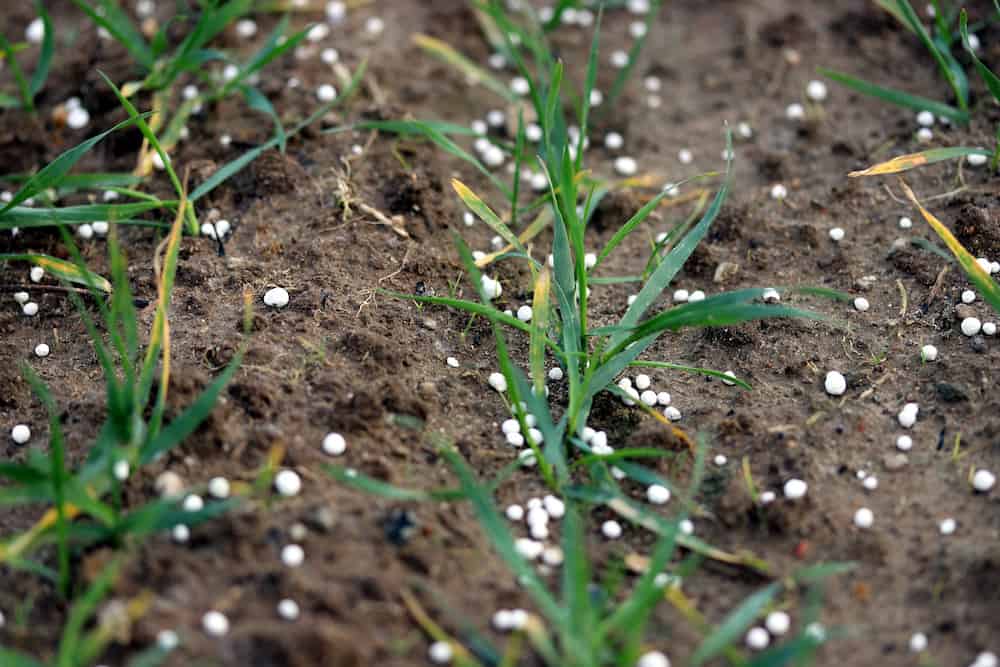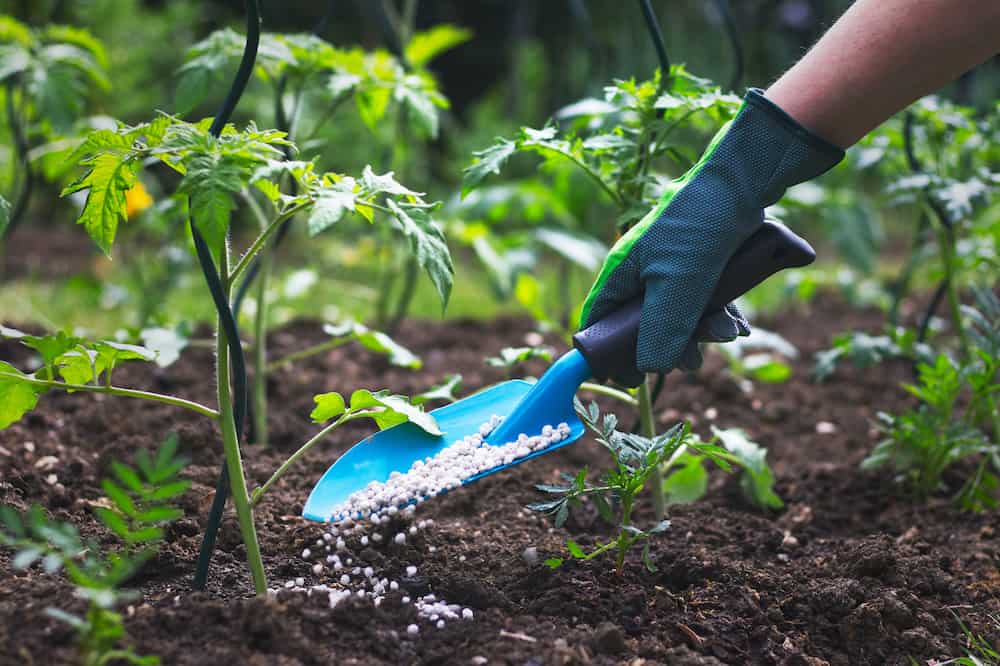Plants need additional nutrients that can help them flourish and prevent diseases. Among the many methods to ensuring your plants grow at a healthy rate, using calcium nitrate is recommended.
Calcium nitrate helps promote fast growth and provides plants with the right amount of nutrients. Plus, it’s easy to apply, and you can find it in almost any gardening store.
What is calcium nitrate made out of? How does it really work?
Here you will learn how to use calcium nitrate for plants, what it is, and what it does.
What Is Calcium Nitrate?
Calcium nitrate is a synthetic chemical mixture of two inorganic compounds—calcium and nitrogen.
To make calcium nitrate, manufacturers combine nitric acid with limestone. Limestone is a good source of calcium carbonate. The reaction between nitric acid and limestone produces calcium nitrate and carbon dioxide.
After that, they add ammonia. Ammonia neutralizes the nitric acid and forms a compound known as a double salt. This compound crystallizes and forms into a salt-like compound. Calcium nitrate looks like chunks of sea salt.
This finished compound can then be placed into water at home, and is one of the only sources of water-soluble calcium, making it excellent for plants. You can break this up into small particles and mix it into the water before applying it to your plants.
Do not make your own calcium nitrate. Buy pre-made calcium nitrate from a gardening center. The part you “make” is combining it with water at home.
Calcium Nitrate Fertilizer
You will find it available as an additive as a white to light gray granular solid. The chemical compound is water-soluble and is easy for plants to absorb.
Unlike humans, plants get most of their nutrients and food by absorbing them through the roots or from the sun.
For the most effective results, you can use calcium nitrate fertilizer by stirring it into the water and then spraying it on your crops.
Alternatively, you may be able to find calcium nitrate fertilizer that’s already dissolved in a liquid form.
Foliar Spray
Foliar feeding is when you spray the leaves instead of the soil.
There’s more than one type of calcium nitrate fertilizer, but the best method, we believe, is using a foliar spray. This is crafted using calcium acetate, calcium nitrate, and calcium chloride.
The compound is quick to get absorbed and allows you to keep the soil’s pH level the same. Aside from that, it’s beneficial for seedlings or transplants.

Calcium Nitrate Granules
Alternatively, you can use calcium nitrate granules and scatter them in your soil before planting. This will help improve the soil quality and prevent the plants from getting any diseases as they age.
The only downside is that this does tend to change the pH balance of the soil. We only recommend using granules if you are trying to cover a large area outdoors.
Mixing the right amount can be tricky, and if you’re using an indoor plant, it can lead to repeat exposure to the compound. This could cause serious side effects that may hurt your health.
When to Use Calcium Nitrate Fertilizer
You can use this additive in several different situations. Knowing what each component does can help you better understand when to use it.
Calcium is essential for plants because it helps them produce quality produce, encourages seed production, and gives the crop a more prolonged shelf life.
It has shown to boost production in citrus trees.
Aside from that, nitrogen is vital for plants to grow healthily. It helps by aiding in amino acid and chlorophyll production. A continuous source of nitrogen can help plants appear more vibrant in color, too.
Here are the three main cases where you should use calcium nitrate fertilizer:
- Nitrogen deficiency in plants
- Calcium deficiency in plants
- To prevent disease in plants
Nitrogen-Deficient Plants
To tell if a plant is nitrogen-deficient, check if the plant’s leaves turn a yellow color. Any yellow-tinted leaves are a sign that chlorophyll is disappearing from the plant.
The discoloration generally starts at the bottom of the plant and then spreads upwards.
Younger plants that start to display nitrogen-deficiency will have stunted growth and will appear smaller than their healthy counterparts.
Once the deficiency spreads, the plant will begin to lose its leaves and will eventually stop growing. When this occurs, it’s only a matter of time before the entire plant wilts and dies.
Also consider coffee grounds for plants for a nitrogen boost.
Calcium-Deficient Plants
On the other hand, calcium-deficient plants will start to turn yellow and brown. The deterioration begins at the very tips of the plant’s leaves, and it will rapidly start to spread downwards towards the body of the plant.
It takes around two weeks for calcium-deficient plants to start to show significant signs of the deficiency.
Younger plants will either halt growth or parts will begin to shrivel up and become wrinkled. The older the plant is, the more rapidly it will spread.
Prevent Disease
One more reason that you’d want to use calcium nitrate is to prevent plant diseases. Some of the diseases that can be avoided are bitter pit, cork spot, and even blossom end rot.
Plants that are planted in nutrient-deficient soil desperately need calcium nitrate. When plants come into contact with calcium nitrate, they absorb the calcium to help them become stronger.
The nitrogen helps with photosynthesis and boosts the plant’s “metabolism.” This means giving them more calcium nitrate can help them enhance their ability to absorb nutrients.
In turn, this then leads to rapid growth and prevents the plant from deteriorating.
Disadvantages of Using Calcium Nitrate
Although there are clear benefits of using calcium nitrate on your plants, there are still some disadvantages
First, it’s a synthetically made chemical substance, not organic. Some farmers want a more natural method to help their plants, and there are plenty of alternatives to calcium nitrate.
Additionally, it works well mainly on plants in a controlled setting. Outdoor plants have a lot of factors that can reduce the effectiveness of using it. In addition, if not done properly, it can be dangerous to use.

How to Use Calcium Nitrate Fertilizer
It comes in multiple forms, which can cause some confusion on how to apply it to your plants. When using calcium nitrate on your plant, you must have the right mixing ratio, which is the application rate.
The application rate can change depending on what brand you use. Each brand lists the application rate on their packaging.
If you’re working with DIY or homemade calcium nitrate, we suggest measuring the crystals’ total weight and mixing in a ratio of water.
Here’s a step-by-step guide you can follow:
Step 1: Measure Calcium Nitrate
Measure out two to four tablespoons of calcium nitrate. If you have more or less land to cover, you may need to make more (or less) of the solution.
As a general rule, use one tablespoon of calcium nitrate per plant watered.
Step 2: Mix With Water
Take a five-gallon bucket and fill it with one gallon of water. Carefully pour the calcium nitrate into the bucket and then mix until fully dissolved.
If using the crystal version, you should stir the mixture until all of the crystals dissolve into the water.
When using the liquid version, you can skip this step.
Step 3: Put in a Spray Bottle
Transfer the mixture into a spray bottle for easy distribution.
Make sure to use gloves when pouring the mixture into the spray bottle. Calcium nitrate can damage your skin, so wearing a protective layer can help keep you safe.
Step 4: Start Spraying
Take the bottle and spray the roots of the plants. After you apply it to your crops, the plant’s cell formation process will be boosted.
On top of that, the chemical compound will also help neutralize acids and assist the plant in detoxing. The nitrogen within the compound will act as a fuel to help increase the plant’s protein production.
Basically, this means that once the plant gets extra nitrogen, it can thrive and grow at quicker speeds.
Calcium Nitrate FAQs
1. What does calcium nitrate do to plants?
Calcium nitrate helps plants by neutralizing acidity. In addition, it helps detoxifies the plant and helps promote healthy cell functions.
The chemical substance acts as a nutrient booster that enhances protein production, leading to a more durable and healthier plant.
Depending on the soil’s nutritional value and surrounding heat and moisture, you may need to use it. Doing so will provide the plant with much-needed nutrition and help stabilize cell growth. This allows the plant to reach its full stage of development.
An excellent method to gauge if you need calcium nitrate is to start by testing your soil. Once you get the results, you’ll know if the soil needs the extra boost.
Once you deposit it onto the plant, the calcium will start to be absorbed into the plant. Over time, it will help strengthen cells and prevent them from collapsing.
What this does is prevent the plant from beginning to die and rot. On the other hand, nitrogen will help boost the plant’s growth rates.
2. Is calcium nitrate dangerous?
According to the New Jersey Department of Health, exposure to calcium nitrate can cause headaches, dizziness, vomiting, and create nausea.
Generally, this only happens if you inhale it or come into contact with your skin or eyes. As such, while dispersing it onto plants, it’s best to wear protective gear. Repeat exposure can also cause a skin rash, itchiness, flakiness, and redness.
Always wear a mask when working with it, as it’s dangerous to inhale.
Aside from that, using goggles can help prevent the eyes from being damaged or irritated.
While it’s not combustible, it can enhance the combustion nature of other compounds. Never mix calcium nitrate with other compounds unless you know what you are doing.
If you take the necessary precautions, working with it isn’t especially dangerous.
However, in the off-chance you do end up coming in contact with the substance, do the following:
- If it comes into contact with your eyes, immediately flush with water for at least 15 minutes at minimum.
- Should the compound comes into contact with your clothing or skin, wash contaminated areas with soap.
- If someone inhales it, you’ll want to start doing CPR if the heart stops. Remove the person from that area and contact a hospital for further instructions.
3. What is the fastest way to add calcium to soil?
The fastest method of adding calcium to the soil is to mix calcium nitrate into the fertilizer or to spray it on.
When you purchase calcium nitrate, make sure that it comes in a foliar spray bottle. To dispense it, spray it onto the plant’s roots, as plants absorb calcium quickest through their roots.
Once applied, you can expect to see results within less than a day.
The calcium will start to do its magic, and the plant will absorb nutrients more efficiently.
Within the next week, the plant will start to improve its nutrient absorption and become lively and bright. To get the best results, use the spray on seedlings or transplants, as this is when they absorb it best. Plus, you’ll be preventing any chances of the plant developing diseases.
4. Do I have to use calcium nitrate for my plants?
Consider also what you are growing. Learn if there are specific nutrients the vegetables and plants need.
It’s important to know what the requirements are for what vegetables you are growing. As an example, you should know what garden plants need lime.
Next, consider your soil. You may want to do soil tests to know what you are dealing with. There are simple soil tests available for you to test the pH level, nitrogen, and more.
If you are starting a garden with poor soil, you may consider growing in pots and containers with amended soil. Other option is to learn how to start composting which will enrich the soil you have.

Calcium Nitrate for Plants
It’s an excellent inorganic fertilizer that can help strengthen your plants. Whether you’re using it to boost your plant’s current health or to prevent diseases, there’s no arguing that it works.
The high calcium count is excellent at providing your plant with the necessary fuel to survive. Plus, the nitrogen helps boost your plant uptake and keeps it growing at an optimal rate.
Calcium nitrate is easy to use and nearly harmless to apply to your outdoor plants. Using the foliar spray method helps to ensure the plants absorb it. Just be sure to take the necessary steps to prevent yourself from coming into contact with the chemicals.
Best Hydroponic Nutrients for a Bountiful Grow
